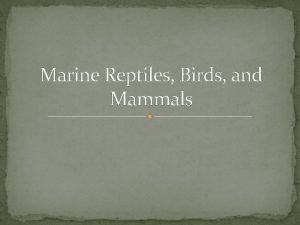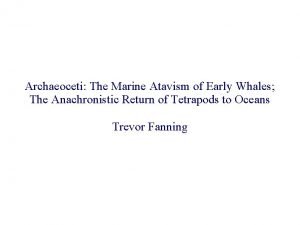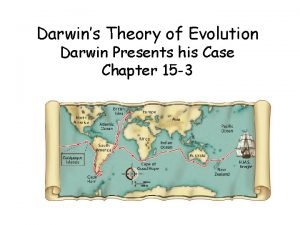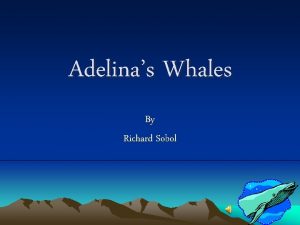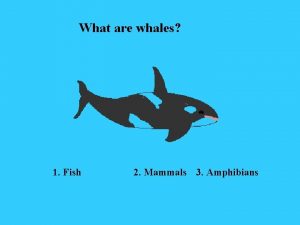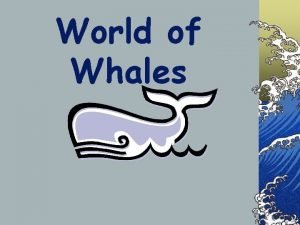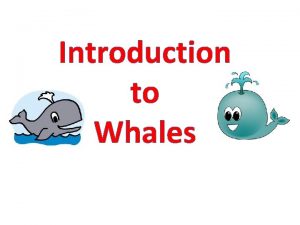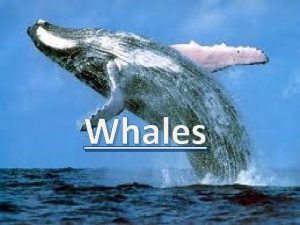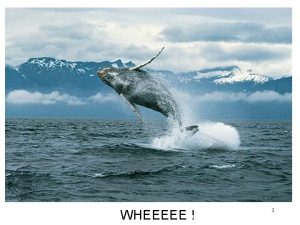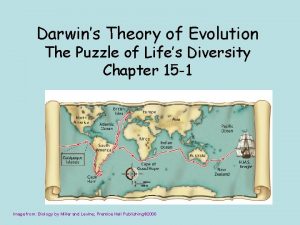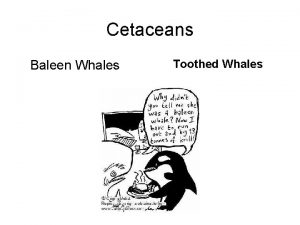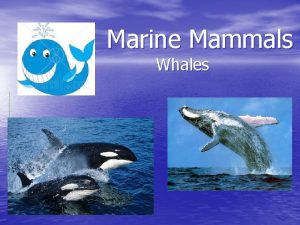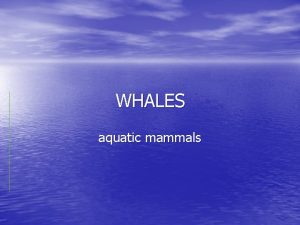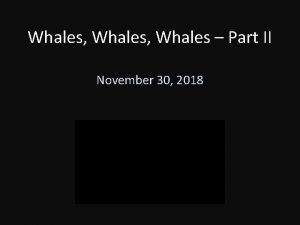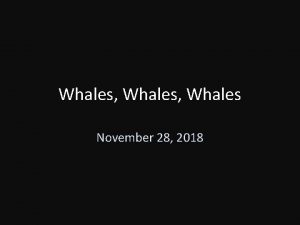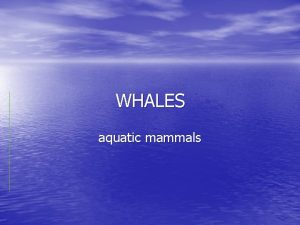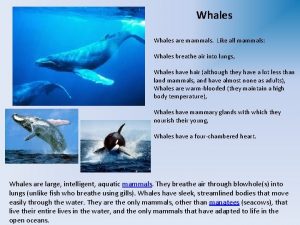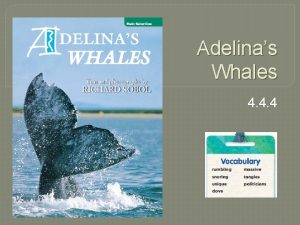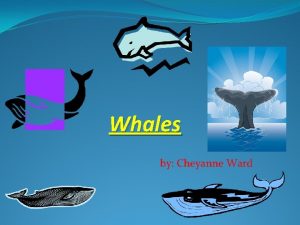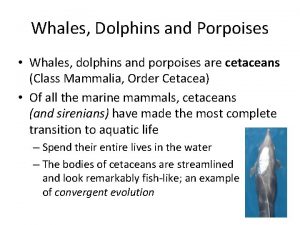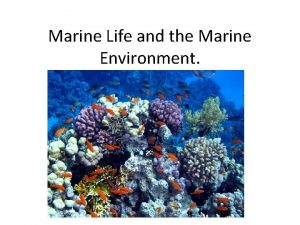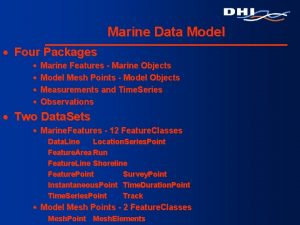Archaeoceti The Marine Atavism of Early Whales The































- Slides: 31

Archaeoceti: The Marine Atavism of Early Whales; The Anachronistic Return of Tetrapods to Oceans Trevor Fanning

Paleontology strengthens theory of evolution through well-defined lineages such as the early whales. Image source: http: //michigantoday. umich. e du/2011/06/whales. php Artist: John Klausmeyer.

The earliest whales were amphibious Eocene mammals. Image source: Wikimedia Commons, from user Arthur. Weasly. Pakicetus inachus, a whale ancestor from the Early Eocene of Pakistan, after Nummelai et al. , (2006), pencil drawing, digital coloring.

Whales evolved from dog-sized land mammals beginning ~ 52. 5 Ma. Pakicetus, one of the oldest known whales, had a longsnouted skull with primitive carnivorous teeth lining its jaws (Benton, 2009). Image source: Wikimedia Commons, from user Arthur. Weasly. Pakicetus inachus, a whale ancestor from the Early Eocene of Pakistan, after Nummelai et al. , (2006), pencil drawing, digital coloring.

Pakicetus's bones reveal it was semi-aquatic. Dense cortical limb bones, instead of spongy bone, helped offset buoyancy in the water. Extant Hippopotamuses have the same bone structure as the early whales.

Modern hippos have compact bones that allow them to wade in the water. Image source: http: //www. freefoto. com/preview/01 -27 -4/Hippopotamus Ref Number: 01 -27 -4 Photographer: Kristin De More

Indohyus was an even-toed herbivore related to early whales. Image source: Wikimedia Commons. Indohyus major, an artiodactyl described as an early ancestor of whales, from the Middle Eocene of Kashmir, after Thewissen, 2007, pencil drawing, digital coloring. Author: Nobu Tamura.

Hippos and Indohyus form sister clades to Cetacea. Image source: Understanding Evolution. 2012. University of California Museum of Paleontology. 22 August 2008 <http: //evolution. berkeley. edu/>.

Whales' nostrils migrated from nose to blowhole in the skull. Image source: Understanding Evolution. 2012. University of California Museum of Paleontology. 22 August 2008 <http: //evolution. berkeley. edu/>.

Vestigial hind limbs in whales no longer protrude from the body. Image source: public domain. Blue whale skeleton with highlighted vestigial limb bones.

Cetacean hind-limbs are perceptible in embryos. Image source: Copyright 2006, Dr. J. G. M. Thewissen

Image source: http: //animals. desktopnexus. com/wallpaper/64884/

In 2001, the first archaeocete astragalus was found. Image source: http: //www. bio. miami. edu/dana/160 S 12_5. html

The double-pulley astragalus is a synapomorphy present in Cetacea and Artiodactyla. Image source: (O'Leary & Gatesy, 2008).

ARCHAEOCETE LOCALITIES: LOCALITIES - The Sulaiman Mountain Range in Pakistan was once the ocean floor of the Tethys Sea. - Before the Indian sub-continent collided with Eurasia, this body of water was a nursery for the budding archaeocete lineage.

The Tethys Sea Existed During The Eocene. Before the Indian subcontinent merged with Eurasia 50 mya (resulting in orogeny of Himalayas), the Tethys Sea spanned this gulf. Image source: Reef Education Network.

Wadi Al-Hitan, Egypt (Arabic for “Valley of the Whales”) Image source: Public domain. Archaeocete vertebrae are roped off in Wadi Al-Hitan.

Fayoum, western desert of Egypt, was submerged during the Eocene. Image source: http: //www. flickr. com/photos/mollymegan/

Ambulocetids were hybridized: partially terrestrial, partially aquatic. Ambulocetus natans Ambulo, -are, -avi, atum: to walk Natans, -antis: swimming, marine i. e. , genus named for its retained capacity to walk on land. Image source: http: //www. indiana. edu/~ensiweb/lessons/whale. ev. html Artist: Carl Buell

Taxonomy, ambulations of Ambulocetus Class - Mammalia Order Cetacea Family - Archaeoceti Genus – Ambulocetidae -------------------- Ambulocetus's posture on land was probably crouched, with its carriage similar to a modern seal's. Likely swam by paddling hind legs. Possibly used full body (caudal Image source: Kelly Taylor Illustration Artist: Kelly Taylor www. keltaysart. com

Remingtonocetidae Named after Remington Kellogg (1892 -1969), the authority of his day on fossil whales. Pictured (bottom) is the remingtonocetid typespecimen Kutchicetus. Image source: public domain, Remingtonocetus Remingtonocetid was small, roughly the size of a river otter! (Bird for scale). Image source: http: //www. neomed. edu/DEPTS/ANAT/Thewissen /whale_origins/whales/Remi. html Artist: Carl Buell

Protocetids may have given birth on land. Image source: Gingerich et al. , 2009, PLo. S. This protocetid, Maiacetus inuus, died and was fossilized during gestation. The fetus's bones are colored in blue.

The land birth model supports the hypothesis that protocetids were amphibious. Image source: Gingerich et al. , 2009, Plo. S. It is proposed that Maiacetus could support its weight on land.

Basilosaurus was the first fossilized Archaeocete to be discovered by humans (early 1830 s). Image soure: Wikimedia Commons Artist: Pavel Riha A misnomer like Oviraptor or the Phytosaurs. The saurus suffix implies this whale was a reptilian (lizard) like the much longer-extinct plesiosaurs!

The first Basilosaurus fossils were exhumed in south Caldwell Parish. . Image source: Public domain; Map of LA with Caldwell Parish highlighted red. Image source: Dmitry Bogdanov Basilosaurus cetoides http: //en. wikipedia. org/wiki/File: Basilosaurus 1 DB. jpg

Basilosaurus was the largest creature of its time, marine or terrestrial. Image course: Wikimedia Commons; Author: Conty. http: //en. wikipedia. org/wiki/File: Basilosaurus_SIZE_01. png Size comparison between the extinct whale Basilosaurus and a human.

contrasted with the primordial Ambulocetus skeletons. The long-bodied archaeocete with negligible hind legs, was a basilosaurid, evolving much later than the early Ambulocetus.



Odontoceti & Mysticeti

References Bajpai, Sunil, and Philip D. Gingerich. "A new Eocene archaeocete (Mammalia, Cetacea) from India and the time of origin of whales. " Proceedings of the National Academy of Sciences of the United States of America 95. 26 (1998): 15464. Academic Search Complete. EBSCO. Web. 24 Apr. 2011. Bajpai, S. , J. Thewissen, and A. Sahni. "The origin and early evolution of whales: macroevolution documented on the Indian Subcontinent. " Journal of Biosciences 34. 5 (2009): 673 -686. Academic Search Complete. EBSCO. Web. 24 Apr. 2011. Phillip D. Gingrich, et al. "Origin of Whales from Early Artiodactyls: Hands and Feet of Eocene Protocetidae from Pakistan. " Science 293. 5538 (2001): 2239. Academic Search Complete. EBSCO. Web. 24 Apr. 2011. Phillip D. Gingerich, et al. "New Protocetid Whale from the Middle Eocene of Pakistan: Birth on Land, Precocial Development, and Sexual Dimorphism. " PLo. S ONE 4. 2 (2009): 1 -20. Academic Search Complete. EBSCO. Web. 24 Apr. 2011. Maureen A. O'Leary and John Gatesy. “Impact of increased character sampling on the phylogeny of Cetartiodactyla (Mammalia): combined analysis including fossils. ” Cladistics 24, 397 -442 (2008). Academic Search Complete. EBSCO. Web. 24 Apr. 2011. Thewissen, J. G. M. , and Sunil Bajpai. "Whale Origins as a Poster Child for Macroevolution. " Bio. Science 51. 12 (2001): 1037. Academic Search Complete. EBSCO. Web. 24 Apr. 2011.
 Killer whale eating sea lion
Killer whale eating sea lion Atavism poem
Atavism poem Atavism poem
Atavism poem Whale atavism
Whale atavism Early cpr and early defibrillation can: *
Early cpr and early defibrillation can: * Adelina's whales reading street
Adelina's whales reading street Whales use to walk on land
Whales use to walk on land Whales have vestigial legs. this suggests they _____.
Whales have vestigial legs. this suggests they _____. Adelina's whales comprehension questions
Adelina's whales comprehension questions Cetaceans
Cetaceans What is this
What is this Peta save the whales lose blubber ad
Peta save the whales lose blubber ad 2 freinds 1 fish
2 freinds 1 fish Symphony of whales
Symphony of whales Adelinas whales
Adelinas whales Enchanted learning whales
Enchanted learning whales Whales characteristics
Whales characteristics Save the whales readworks answer key
Save the whales readworks answer key The story of the three whales
The story of the three whales Whales are sea living mammals
Whales are sea living mammals Whale phylum
Whale phylum The great whales
The great whales Whales food web
Whales food web Whales have vestigial legs. this suggests they _____.
Whales have vestigial legs. this suggests they _____. Symphony of whales read aloud
Symphony of whales read aloud Trời xanh đây là của chúng ta thể thơ
Trời xanh đây là của chúng ta thể thơ Slidetodoc
Slidetodoc Thiếu nhi thế giới liên hoan
Thiếu nhi thế giới liên hoan Thế nào là số nguyên tố
Thế nào là số nguyên tố Phối cảnh
Phối cảnh Các châu lục và đại dương trên thế giới
Các châu lục và đại dương trên thế giới Thế nào là hệ số cao nhất
Thế nào là hệ số cao nhất
